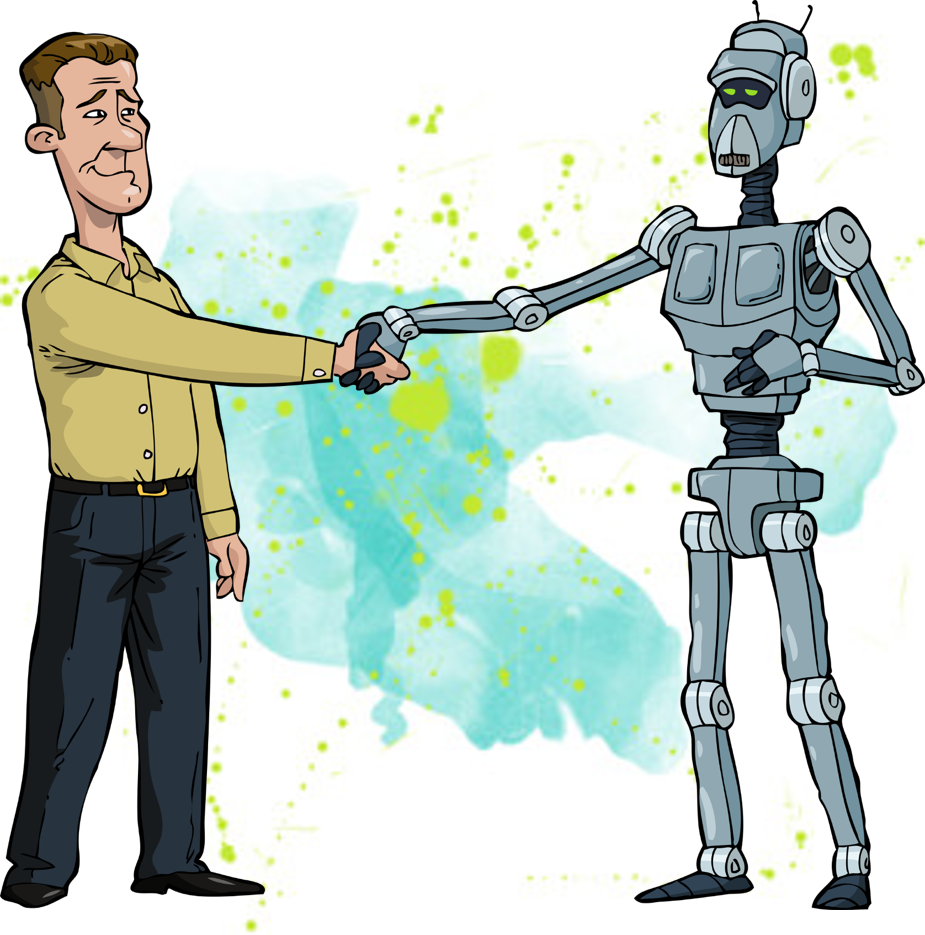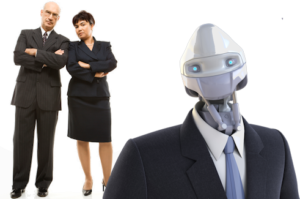One of the pressing questions of the digital age is whether humans will have a place in the workforce of the future. For people looking for some sign of hope amidst all the bad news about robots and automation taking jobs, Google’s July 2017 announcement should provide a ray of hope.[1] Google announced it was starting a “$50 million initiative to study and prepare ‘for the changing nature of work,’ beginning with investments in the U.S. and Europe to help train job seekers and improve the working conditions for those already employed.” As Tony Romm (@TonyRomm) puts it, “Google.org is studying the economic effects precipitated in no small part by its own parent company, Alphabet.”[2] Dark scenarios in which unemployment rates skyrocket resulting in social chaos and economic collapse generally rely on a human-versus-machine story line. What Google and others are trying to create is a future in which humans and machines are collaborative rather than confrontational.
Human/Machine Collaboration
Aaron Rosland, a Canadian politician, has read all of the bleak predictions about future employment; nevertheless, he is a self-proclaimed optimist about artificial intelligence (AI).[3] He explains, “More and more, we are seeing a future where man plus machine is becoming a way of life; where everything in our daily lives from healthcare to banking can be augmented. It’s the future where thousands of new jobs are made not eliminated, a future where AI is additive.” Alec Sears is also an optimist. He writes, “Like it or not, AI is here to stay. The technology has tremendous potential to boost productivity and efficiency, in both small businesses and multinational corporations. Think of this technology as a helpful productivity guru ready to help you learn and serve your enterprise.”[4] Satya Nadella (@satyanadella), Microsoft’s CEO, is betting the company’s future on AI. Nevertheless, he believes human/machine collaboration will characterize the future. During a conversation at a conference held in Munich, Germany, he remarked, “[The future] is going to be about people working with machines. So that means you have got to be able to understand machines and how they work. There is no walk of life that is not going to require computational understanding.”[5] He continued, “I think it is the coming together of liberal arts and sciences that are going to keep human creativity and ingenuity [alive] in an age where machines are intelligent.”
Even though many pundits believe the future will be characterized by human/machine collaboration, most of those same pundits understand this brave, new world is not going to emerge without some growing pains. David Weldon (@DWeldon646) points out, “While the use of automation and artificial intelligence technologies is increasing, they will become widely used in the coming years and have a profound impact on the workforce and job security. Many low skill jobs will be lost. Some new highly skilled jobs will be created. Most jobs will be impacted to some degree.”[6] Chris Cancialosi (@gothamCulture), founder of gothamCulture, adds, “If you still aren’t convinced that cognitive technology is going to impact your life and business, think again. … It’s already happening.”[7] People whose livelihoods are threatened by AI are not happy machines are getting smarter. Only a fool would deny automation and AI are going to cost some people their jobs. With some retraining and reskilling, however, most people can learn to collaborate with machines in the workplace. Cancialosi reports, “IBM prefers the term ‘augmented intelligence’ over artificial intelligence. They believe that rather than computers taking over for humans, cognitive technology will serve a critical role in augmenting the humans it supports. This augmented intelligence will create unparalleled opportunities to draw out the full capacity and potential of the human spirit by relieving people of transactional and mundane tasks that take up so much time today.”
The Future Workforce
Weldon discusses a Forrester report written by J. P. Gownder (@jgownder) entitled “Automation Technologies, Robotics, and AI in the Workforce, Q2 2017.” In that report, Gownder “warns that millions of jobs are at stake as we change how tasks are performed.” Gownder makes an important distinction between jobs and tasks. A job can be made up of numerous tasks. Historically, automation has focused on relieving humans of performing routine or mundane tasks. That focus is unlikely to change. Nevertheless Gownder warns, one of the most difficult, but important roles ahead for managers will be “the task of eliminating jobs.” He predicts, “Automation will displace 24.7 million jobs in the US by 2027. … Most at risk will be jobs like office administrators, salespeople, construction workers, and call center employees, though there is a long list of other positions as well.” Although that sounds like a dire prediction, Gownder clarifies it by noting, “Because of automation, your company is likely to eliminate jobs, too, but not necessarily via layoffs. Many of these jobs will be ‘lost’ in the sense that, absent automation, they would otherwise have materialized over time. One company told us that it reduced employment in a shared service function by 8 percent and capped future hiring but gained far more efficiency for those remaining. For you, this means developing a strategic viewpoint on the future size and scope of your workforce and how automation should play a role.”
According to Gownder, some of the job losses will be offset by new jobs. He predicts, “The new automation economy will also create jobs — an estimated 14.9 million new jobs in the US by 2027.” Obviously, these new jobs will require skill sets much different than those involved in lost jobs. This means effective programs for retraining and reskilling employees must be established if unemployment rates are not going to soar. “Some of these jobs will fall under the technology management umbrella,” Gownder says, “and all of them will deeply link to your automation infrastructure.” Reskilling, retraining, and hiring this new workforce will require a partnership between technology and HR leaders “to develop a strategy for recruiting, training, and managing the right skill sets for the automation economy. Employees with science, technology, engineering, and math skills are obvious additions.” Gownder adds, “Change management professionals [will also be needed] to help mixed human machine digital workforces succeed.”
Summary
Gownder insists humans will have to learn to work side-by-side with robots. That’s good news because it means there will still be work for humans in the decades ahead. Kevin Kelly (@kevin2kelly), founding Executive Editor of Wired magazine, explains, “This is not a race against the machines. If we race against them, we lose. This is a race with the machines. You’ll be paid in the future based on how well you work with robots. Ninety percent of your coworkers will be unseen machines. Most of what you do will not be possible without them. And there will be a blurry line between what you do and what they do. You might no longer think of it as a job, at least at first, because anything that resembles drudgery will be handed over to robots by the accountants.”[8] Who should be worried? Andrew Ng (@AndrewYNg), a well-known AI expert and founder of Coursera, notes, “The broader pattern is that in any task in which a lot of people are doing relatively routine, repetitive work, that creates a very strong incentive for AI teams to come and automate that task. There is one other rule of thumb, which is that almost anything a typical human can do with less than one second of mental thought, we can probably now or in the near future automate using AI.”[9] To hedge against being a victim of automation in the years ahead, Ng recommends every employee becoming a lifelong learner. “We’re entering an era in which lifelong learning is no longer optional,” he states. “The old model of education, where you go to college for four years and coast through the next 40 makes no sense in today’s rapidly changing world. In IT, half the stuff we invent today will be obsolete in five years. The sands are constantly shifting. You have to keep learning. This is becoming much more pervasive elsewhere in our economy, too. So tell your children: ‘Learn to be lifelong learners’.” That’s good advice for all us who hope to be working in the years ahead. Rosland adds, “If, like me, you prefer the man plus machine scenario, then grab a place at the table. There are seats — but they’re filling up fast.”
Footnotes
[1] Tony Romm, “Google.org is launching a $50 million effort to prepare job seekers for the ‘future of work’,” Recode, 26 July 2017.
[2] Ibid.
[3] Aaron Rosland, “Why I’ve Become an AI Optimist,” Computer Business Review,
[4] Alec Sears, “Artificial intelligence is coming for your job (to make it easier),” KSL News, 28 July 2017.
[5] Madhumita Murgia, “Satya Nadella, Microsoft, on why robots are the future of work,” Financial Times, 29 January 2017.
[6] David Weldon, “Automation, AI will transform tomorrow’s workforce,” Information Management, 10 July 2017.
[7] Chris Cancialosi, “Can Artificial Intelligence Unlock Our Full Potential At Work?” Forbes, 15 November 2016.
[8] Kevin Kelly, “The Seven Stages of Robot Replacement,” Backchannel, 27 December 2016.
[9] Jason Dean, “The Optimistic Promise of Artificial Intelligence,” The Wall Street Journal, 13 June 2017.





